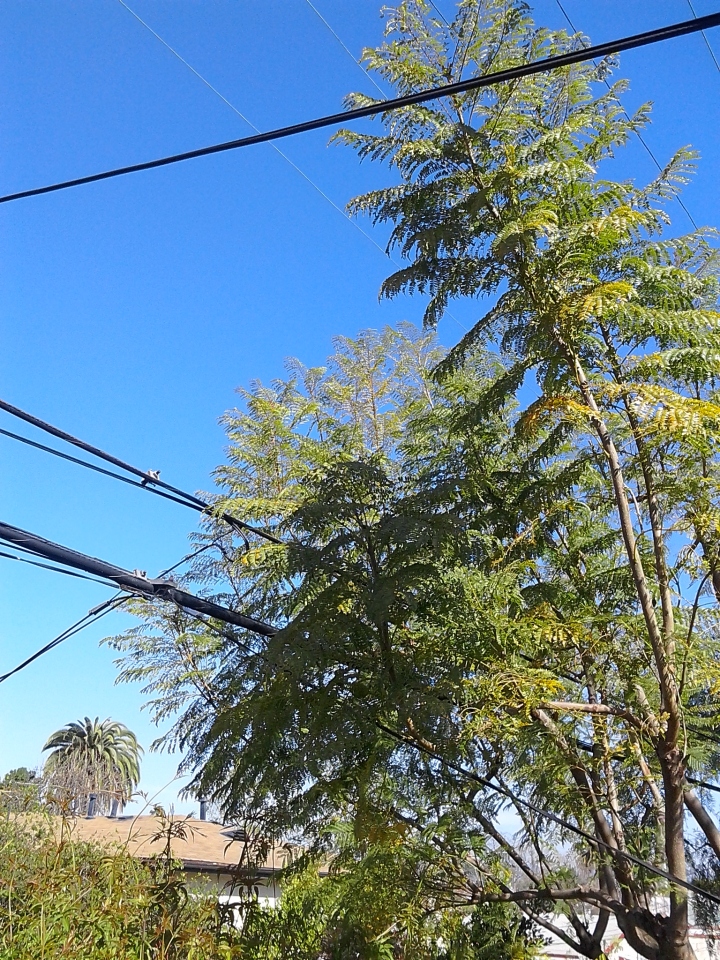 Roots hold up trees. That is part of their job. They grow along with the trees they support, and disperse as necessary to maintain stability. Trees grown within the confinement of cans (pots) or boxes, and then installed into a landscape, are typically staked temporarily until their roots adequately disperse and stabilize. Once unnecessary, stakes and bindings must be removed.
Roots hold up trees. That is part of their job. They grow along with the trees they support, and disperse as necessary to maintain stability. Trees grown within the confinement of cans (pots) or boxes, and then installed into a landscape, are typically staked temporarily until their roots adequately disperse and stabilize. Once unnecessary, stakes and bindings must be removed.
Mature palms that get relocated are supported temporarily by guy wires. They are just too big to be supported by stakes. Because palm trunks to not grow any wider as at they grow taller, they are not damaged by the sorts of bindings that would damage the fattening trunks of other trees. Like stakes on other trees, guy wires must be removed as they become unnecessary.
Although they can be appropriate in unusual circumstances in which stakes would not be practical, guy wires are rarely used on trees that are not palms. Mature trees that get relocated can be guyed if too big to be supported by stakes. Because trunks and limbs of such trees expand (circumference), it is more important for guy wires to be remove when they become obsolete.
As useful as guy wires can be, they are more often used improperly or inappropriately. Firstly, those who install them rarely do so correctly, with the wires or cables as straight as possible between each end. Cabled anchors are usually pounded into the ground perpendicularly to the direction of the cable, so that the cable merely slices through the soil when tension is applied.
Once installed, cables are very often left in place long enough to constrict the growing trunks or limbs that they are attached to. Cables that apply too much tension or limit the motion of the trees they support (in the breeze) for too long will actually inhibit root dispersion. Trees will only become as stable as they need to be. Besides all this, lingering cables are just plain unsightly.
The cabled trees in these pictures demonstrate another set of problems that should be corrected by simple and necessary pruning, and comparably necessary adjustment of the automated irrigation. Guy wires should most certainly not be necessary for such mature trees of this species, and will interfere with necessary root dispersion without remedying the primary problems.
Firstly, the trees are too low and dense. Even if stability were not a concern, they should be pruned for a bit more clearance above the patio to the right of the picture, and perhaps allow a bit more sunlight to the plants below, even if only temporarily. More importantly, pruning would temporarily decrease weight and wind resistance of the canopies while roots adapt accordingly.
Secondly, the landscape is getting irrigated too much, even for the ferns in the background. This maintains soil saturation so that stabilizing roots can not disperse into deeper strata. Roots that might have extended deeper earlier will drown and rot. Until this happens, excessive irrigation promotes heavy superfluous growth that the compromised root system can not support.
Automated irrigation should be disabled for winter, and operated only manually and minimally if the weather stays dry long enough for the ferns to get drier than they are comfortable with. It can be adjusted accordingly when reactivated in spring. Even before that happens, and roots disperse, the guy wires can be removed as soon as these trees get pruned as they should be.
 Like Michael Jackson said, “You got an easement on down the road.”. . . or something like that. In older neighborhoods, that is where the utility easements are usually located. These are zones for utility poles that suspend electrical, telephone and television cables. When electricity first became available, that was the easiest place to put the cables, and the practice continued for decades.
Like Michael Jackson said, “You got an easement on down the road.”. . . or something like that. In older neighborhoods, that is where the utility easements are usually located. These are zones for utility poles that suspend electrical, telephone and television cables. When electricity first became available, that was the easiest place to put the cables, and the practice continued for decades.